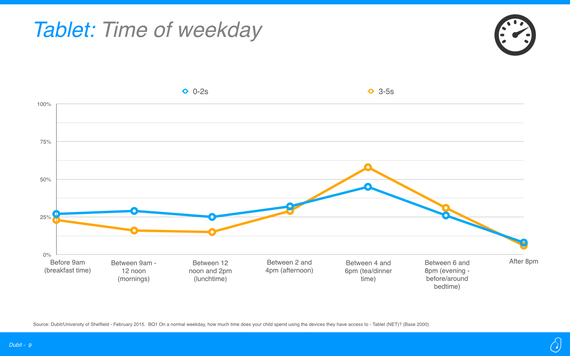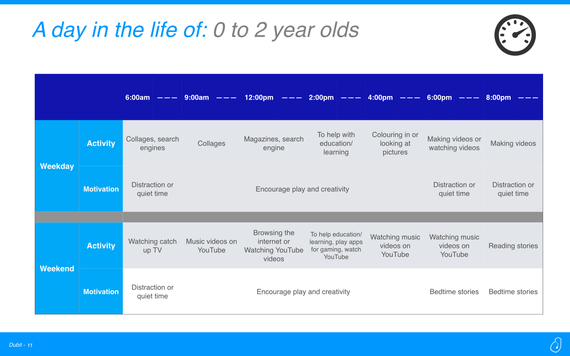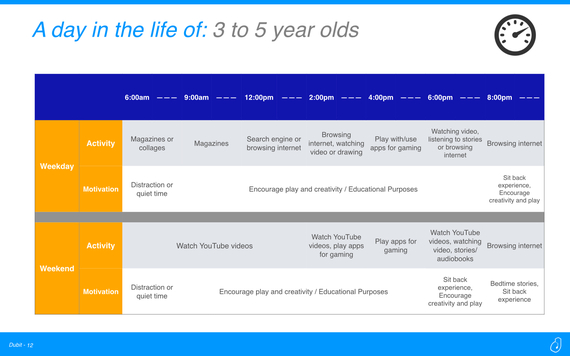By now, to say that tablets and mobile apps are popular among young children is superfluous, akin to saying they like sweets. A new study, however, shares rich detail of under-5s' surprising digital competencies, as well as how mobile media use is shaped by - and shapes - kids' daily routine and emotional states.
The report is aimed at app developers, to encourage reflection about design choices and play patterns they employ to engage young people.
Study Elements
The research with UK children was conducted by the University of Sheffield, development studio and consultancy Dubit, the University of Edinburgh, CBeebies, production company Foundling Bird, and Monteney Primary School in Sheffield. It involved three stages:
- An online survey of 2000 parents with 0-5 year olds who have tablet access;
- Five home visits each with six families, interviewing parents and filming the children using tablets (some parents also collected video using smartphones and/or a child-size 'Go-Pro' chest-cam);
- Videotaping 4- and 5-year-olds from the first phases playing with favorite apps).
We've all seen videos of children trying to swipe a book like a touchscreen, or heard parents brag about their preschooler's ability to access and play favorite apps. This study isolates discrete gestures and functions in those capacities.
The easiest unassisted task across all ages is swiping to turn pages or move through scenes. With assistance, older kids (3-5) are almost equally capable of finer motor abilities like dragging an item, tapping the screen, or tracing a shape, though younger children (0-2) are less able. Pinching or expanding fingers to resize objects is challenging for all. Younger children are not yet able to undertake basic tablet functions like unlocking the device and changing volume.
When it comes to genres, all ages find learning and creativity apps easiest; perhaps these are the most likely to be designed with developmentally-appropriate practice" (DAP) in mind.
They have more trouble with games, not surprisingly as the study found even very young children try to play their parents' casual games (e.g., "Candy Crush"). This suggests a market opening for games with similar mechanics, but simpler challenges and open-ended play.
Emotional Scheduling
The schedule is dead; long live the schedule. It's another truism that today's children watch or play what they want, when they want it. The ethnographies in this study, however, revealed patterns that Dubit researchers refer to as "emotional scheduling," tied to availability, location, family needs and moods.
On a typical weekday, there's a spike in tablet use between 4-6 pm. This may reflect older children returning from preschool or day care, the need for afternoon "down time," or parents' need to prepare supper. Weekends show more even use across the day.
Time of day also influences where kids use a tablet, what app genres they choose, adult co-play, and parent motivation in permitting digital playtime. Daylong, most use takes place in the lounge or sitting room, but bedroom use spikes in the evening. Parents are seeking creative play and learning during the day, but distraction and quiet time in early mornings and afternoon "tea time." (4-6 pm is the only period when gaming dominates.)
Supporting Play and Creativity
Beyond competencies and habits, the study focused on factors that support or undermine play and creativity. In this regard, this work is a useful complement to the recent Hirsh-Pasek et. al. rubric for evaluation of apps' educational value built around four pillars: "minds on" active involvement, engagement, meaningful experience, and social interaction.
This report also recommends focus, clearly articulated purpose, embedded critical thinking and problem solving, links to experiences in the "offline" world, and opportunities for co-play. It also goes into detail about interface features that can promote clarity in play and navigation, such as consistency in type of touch required, big targets for small fingers, aural or visual support in early screens, and ways for parents either to level the app or to turn off advanced features.
Conclusions
0-2 and 3-5 are very broad age ranges for DAP, given the pace of early child development. Many developers already level apps so they can grow more complex as the child ages, and finely target their content and interfaces. This can be a challenge to achieving a sustainable audience, but is critical to not frustrating young users.
Mobile media will never be "appointment viewing," but the findings around emotional scheduling suggest that developers do need to consider the when and where of app use. A wind-down e-book will be very different in tone, design, interactivity and description from a game designed for active, physical play.
The full report includes details of parents' and kids' favorite app genres, more on what elements parents respect and kids love, and insights into unpleasant experiences for (a small minority of) parents.
Further, this is just the first report from this data. This fall, a report for parents will suggest best practices in choosing and using media with babies and toddlers.
This column first appeared in Kidscreen Magazine's iKids.



